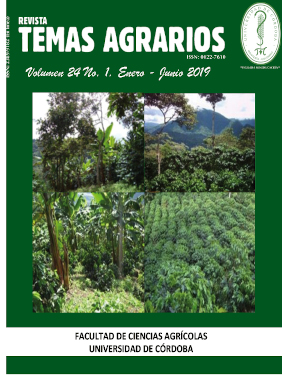Study of the reproductive characteristics of carnation hybrids (Dianthus caryophyllus)
Estudio de las características reproductivas de híbridos de clavel (Dianthus caryophyllus)
Show authors biography
Carnation is the most important flower in the exportation and the principal destination are United States of America and Europe and the country is the first producer of carnation in the word. The vascular diseases are the most important cause of losses in the crop and the most efficient method of control is to count to resistant varieties. The recognitions of the reproductive characteristics of the carnation hybrids, object of this work, permitted in a prudent period establish a program of varieties production in Colombia. In this work we used hybrids of three successive generations obtained by autopollination studding the reproductive characteristics. As much as pollen and ovules in the flowers, as well as in the male and female reproductive organs we find a high variability in the number of structures, were the reproductive variability is not bound to the endogamous generation. The pollen quantity is not directly bound with the number of seeds produced, as well as with the number of ovules in the gynoecium. Conversely, the seeds number is related directly with the number of viable ovules by flower. The hybrid fertility expressed in terms of number of pollen grains vs fertilized ovules and produced seeds by flower show that exist a plenty variability in the reproductive conditions in the hybrids, but enough to permit a successful production of seeds.
Article visits 1145 | PDF visits
Downloads
- Bilbao, O. y Castro, C. 1995. Estudios preliminares para la obtención de semilla híbrida de clavel estándar bajo las condiciones de la sabana de Bogotá. Trabajo de grado de Ingeniero Agrónomo. Universidad Nacional de Colombia (Bogotá). 39-43; 46; 68-70.
- Dyaberi, A., Dhananjaya, M., Kumar, R. and Rao, M. 2015.Floral biology and seed setting in standard carnation (Dianthus caryophyllus). Indian Journal of Agricultural Sciences 85(9): 1175–80.
- Filgueira, J. 2009. Estudio y manejo de la pudrición basal producida por hongos del complejo Fusarium en clavel comercial en la Sabana de Bogotá. Asocolflores 72: 53-54.
- Filgueira, J. 2011. Experiencias en mejoramiento del clavel (Dianthus caryophyllus). Universidad Militar Nueva Granada 1ª Ed. Bogotá Colombia. ISBN 978-958-8403-41-0.
- Franklin, V. and Rudd, J. 2003. Signals and targets of the self-incompatibility response in pollen of Papaver rhoeas. Journal of Experimental Botany, 54(380): 141-148.https://doi.org/10.1093/jxb/erg001
- Henao, L. Clavijo, M., y Filgueira, J. 2007. Capacidad auto reproductiva y morfología floral de algunas líneas experimentales de clavel (Dianthus caryophyllus). Revista Facultad de Ciencias Básicas Universidad Militar Nueva Granada 3(1): 115-125.
- Jensen, W. and Salisbury, F. 1994.Botany. Mc Graw-Hill. México. 562-573.
- Kearns, C. and Inuye, D. 1993.Techniques for pollination biologist. University Press of Colorado. 36-45; 64-75; 90-106; 112-122.
- López-Torres, M. 1995. Fitomejoramiento. Editorial Trillas. México. 24(93): 141-144.
- Ramsey, M. and Vaughton, G. 2000. Pollen quality limits seed set in Burchardia umbellata. American Journal of Botany 87: 845-852. https://doi.org/10.2307/2656892
- Rosenhaim, J., Shreiber, S. and Williams, N. 2016.Does an ‘oversupply’ of ovules cause pollen limitation? New Phytologist 210: 324–332. https://doi.org/10.1111/nph.13750
- Shreiber, S., Rosenhaim, J. Williams, N. and Harder, L. 2015. Evolutionary and ecological consequences of multiscale variation in pollen receipt for seed production. The American Naturalist 185(1). https://doi.org/10.1086/678982
- Soto-Sedano, J., Clavijo-Ortiz, M.J. and Filgueira-Duarte, J.J. 2012. Phenotypic evaluation of the resistance in F1 carnation populations to vascular wilt caused by Fusarium oxysporum f.sp. dianthi. Agronomía Colombiana 30(2): 172-178.
- Ramsey, M. and Vaughton, G. 2000. Pollen quality limits seed set in Burchardia umbellata.American Journal of Botany 87: 845-852. https://doi.org/10.2307/2656892
- Soto, J., Clavijo, M. and Filgueira, J. 2013. Floral evaluation and reproduction capacity of Dianthus caryophyllus cultivars for a breading program. Acta Horticulturae 1000: 429-432. https://doi.org/10.17660/ActaHortic.2013.1000.59
- Wilson, C. 2001.Floral stages, ovule development, and ovule and fruit success in Iris tenax, focusing on var. Gormanii, a taxon with low seed set. American Journal of Botany 88: 2221-2231.https://doi.org/10.2307/3558384




















